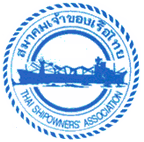| History |
|
| The seeds that would
later bloom into the Thai Shipowners' Association were planted at a
1973 meeting of the Association of Southeast Asian Nations (ASEAN).
At this point ASEAN has only five members - Indonesia, Malaysia,
Philippines, Singapore and Thailand - all of them fledgling
economies in the early 1970s. In order to improve their status and
become major players on the world stage, they agreed that they
needed to not only standardize their key industries but also enhance
cooperation between their private sectors. Among the many
collaborative efforts spawned that year, was the birth of the
Federation of ASEAN Shipowners Association, which was charged with
standardizing and strengthening the member nations' shipping and
marine transportation industries. ASEAN astutely noted that some of
its members weren't as advanced in shipping and needed assistance in
developing marine logistics. Hence, it envisioned a federation in
which the countries with the highest tonnage would assist and
undertake marine logistics for their neighbors with lower export
volumes. Since a strong shipping industry is a key component of
export-driven economies like those in Southeast Asia, the
association was convinced that all of its members would prosper if
they worked hand in hand assisting on another. At the time Thailand had only the Bangkok Shipowners and Agents Association (BSAA) operating as the representative body for shipper and freight forwarder. But a new organization was needed, one that could partner with similar associations in ASEAN. After the ASEAN meeting in Kuala Lumpur the Thai government, intending to form a reciprocal shipowners' trade group, commissioned the Thai Maritime Navigation Co., Ltd. which would operate as state owned enterprise under the Transport and Communication Ministry. Thai Maritime was given the charge of creating the Thai Shipowners' Association within six months. Rear Admiral Bunpot Sudsawaeng was asked to head up Thai Maritime as its managing director, a post which he ably stepped into. One of his first orders of business was to invite some of the country's largest shipping firms - Thai Mercantile Marine Ltd. and Thai International Maritime Enterprises Ltd. - to the table to discuss the creation of TSA. These two concerns were already members of the Thai-Japanese and Japanese-Thai Shipping Clubs. With two ship operators at the table, Rear Admiral Bunpot thought it would be prudent to include input from a shipping agency, or a non-vessel operating common carrier (NVOCC), which doesn't own vessels. Thus, he invited Ngow Hock Agency Co., Ltd. to the discussions. As discussions commenced the government became concerned that the public sector wouldn't have enough input in creating this new shipping association. Up until this point, the state had not had much interest in developing the shipping trade, but with a freshly signed agreement with ASEAN nations, it knew it needed to be more involved. At the time the Office of National Economic and Social Development Board regulated the shipping business in Thailand. It created a sub-committee responsible for establishing the association, appointing as its chairman Admiral Jitt sangkhadul, then the permanent secretary of the Defense Ministry as well as chairman of the recently formed Thai Maritime Navigation Co., Ltd. The panel was composed of repsentatives of private industry and the public sector to ensure an open forum and a wide range of views and interests. It was also critical that the committee was able to marshal cooperation from overseas' interests. Public sector members included the Royal Thai Navy, the Commerce Ministry, the Board of Investment, the Transport Ministry and the Foreign Ministry. The private sector members were Thai Maritime Navigation Co., Ltd., Thai Mercantile Marine Ltd., and Thai International Maritime Enterprises Ltd. The NESDB was represented as secretary for the committee. Its chore was a daunting one, but the panel was staffed with dependable and seasoned professionals who could get the job done. The public members were:
Private sector representatives included:
Rear Admiral Bunpot Sudsawaeng also sat on the committee representing the state-owned enterprise, Thai Maritime Navigation Co., Ltd. Without delay, the panel met to draft regulations establishing a shipowners' association. It modeled the new statutes after other countries' shipping associations, particularly those of other ASEAN members as well as those of the BSAA. The group had to work with care, however, to ensure that such an organization didn't conflict with Thailand's Civil and Commercial Code. Mr. Rawee and Mr. Kamol were instrumental in scribing the regulations, which still today serve as the guiding code for the Thai Shipowners' Association. The TSA was registered as a bona fide trade association on October 7, 1975 and it located its offices on Bangkok's Rajdumnern Road on the third floor of the Office of Permanent-Secretary of the Transport and Communication Ministry. Appointed to the charter board of directors were Rear Admiral Bunpot Sudsawaeng, Mr.Yongkit Sotikul and Mr. Waree Weerungkul. Having proven himself to the membership and government as man of action and intelligence, Rear Admiral Bunpot Sudsawaeng was appointed chairman at the association's first meeting. Within a week the TSA organized a party of members who departed on introductory tour, during which they met with colleagues at shipping associations in Indonesia and Singapore. TSA delegates on this tour included:
They toured in part to prove that Thailand had established a shipping association in compliance with the ASEAN agreement from two years earlier and to gear up for and arrange the first ASEAN Shipowners' Federation gathering. With the TSA's creation, the crucial members of the ASEAN shipowners' group were in place and the federation held its first general meeting a month later, in November 1975. Since then, the Thai Shipowners' Association has become an integral force in helping Thailand's shipper and exporters meet the ever-changing demands of global trade. In addition to carrying out its mission, the TSA was responsible for creating the office of Shipping Promotion Board. Chronology: The association's chairpersons since its inception to the present include:
The association's secretaries have included:
|
|
|
TSA Maritime Directory 2004 |
|
